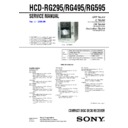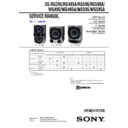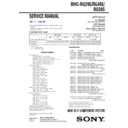Read Sony HCD-RG295 / HCD-RG495 / HCD-RG595 / MHC-RG295 / MHC-RG495 / MHC-RG595 Service Manual online
SERVICE MANUAL
COMPACT DISC DECK RECEIVER
SPECIFICATIONS
HCD-RG295/RG495/RG595
Photo: HCD-RG495
Ver. 1.1 2008.09
– Continued on next page –
9-887-527-02
2008I05-1
© 2008.09
© 2008.09
Sony Corporation
Audio&Video Business Group
Published by Sony Techno Create Corporation
Published by Sony Techno Create Corporation
AEP Model
E Model
HCD-RG295/RG495/RG595
UK Model
HCD-RG295/RG595
Australian Model
HCD-RG295/RG495
• HCD-RG295 is the amplifier, CD player, tape
deck and tuner section in MHC-RG295.
• HCD-RG495 is the amplifier, CD player, tape
deck and tuner section in MHC-RG495.
• HCD-RG595 is the amplifier, CD player, tape
deck and tuner section in MHC-RG595.
Model Name Using Similar Mechanism
HCD-RG490/RG590
CD
CD Mechanism Type
CDM74KF-K6BD83S
Section
Base Unit Name
BU-K6BD83S-WOD
Optical Pick-up Block Name
KSM-213DCP
TAPE
Model Name Using Similar Mechanism
HCD-RG490/RG590
Section
Tape Transport Mechanism Type
CWN42FF609
Amplifier section
European model:
HCD-RG595
Front speaker
HCD-RG595
Front speaker
Power output (rated): 110 W + 110 W
(at 6
(at 6
Ω, 1 kHz, 1% THD)
RMS output power (reference): 180 W +
180 W (per channel at 6
180 W (per channel at 6
Ω, 1 kHz, 10%
THD)
Subwoofer
RMS output power (reference): 180 W
(at 6
(at 6
Ω, 80 Hz, 10% THD)
HCD-RG495
Front speaker
Front speaker
Power output (rated): 95 W + 95 W (at
6
6
Ω, 1 kHz, 1% THD)
RMS output power (reference): 155 W +
155 W (per channel at 6
155 W (per channel at 6
Ω, 1 kHz, 10%
THD)
Subwoofer
RMS output power (reference): 155 W
(at 6
(at 6
Ω, 80 Hz, 10% THD)
HCD-RG295
Power output (rated): 95 W + 95 W (at
6
6
Ω, 1 kHz, 1% THD)
RMS output power (reference): 155 W +
155 W (per channel at 6
155 W (per channel at 6
Ω, 1 kHz, 10%
THD)
Other models:
HCD-RG495
HCD-RG595
The following are measured at AC 120, 127,
220, 240 V 50/60 Hz
Front speaker
220, 240 V 50/60 Hz
Front speaker
Power output (rated): 95 W + 95 W (at
6
6
Ω, 1 kHz, 1% THD)
RMS output power (reference): 155 W +
155 W (per channel at 6
155 W (per channel at 6
Ω, 1 kHz, 10%
THD)
Subwoofer
RMS output power (reference): 155 W
(at 6
(at 6
Ω, 80 Hz, 10% THD)
HCD-RG295
The following are measured at AC 120, 127,
220, 240 V 50/60 Hz
The following are measured at AC 120, 127,
220, 240 V 50/60 Hz
Power output (rated): 95 W + 95 W (at
6
6
Ω, 1 kHz, 1% THD)
RMS output power (reference): 155 W +
155 W (per channel at 6
155 W (per channel at 6
Ω, 1 kHz, 10%
THD)
Inputs:
AUDIO IN (stereo mini jack): voltage
250 mV, impedance 47 kilohms
250 mV, impedance 47 kilohms
Outputs:
PHONES (stereo mini jack): accepts
headphones of 8 ohms or more
SPEAKER: accepts impedance of 6 to
16 ohms
SUBWOOFER OUT (HCD-RG595/
RG495 only): accepts impedance of 6 to
16 ohms
headphones of 8 ohms or more
SPEAKER: accepts impedance of 6 to
16 ohms
SUBWOOFER OUT (HCD-RG595/
RG495 only): accepts impedance of 6 to
16 ohms
The following are measured at AC 120, 127,
220 or 240 V, 50/60 Hz
Front speaker:
220 or 240 V, 50/60 Hz
Front speaker:
Power output (rated): 110 W + 110 W
(at 6
(at 6
Ω, 1 kHz, 1% THD)
RMS output power (reference): 180 W + 180 W
(per channel at 6
(per channel at 6
Ω, 1 kHz, 10% THD)
Subwoofer:
RMS output power (reference): 180 W
(at 6
(at 6
Ω, 80 Hz, 10% THD)
2
HCD-RG295/RG495/RG595
Notes on chip component replacement
•
Never reuse a disconnected chip component.
•
Notice that the minus side of a tantalum capacitor may be
damaged by heat.
Flexible Circuit Board Repairing
•
Keep the temperature of the soldering iron around 270 ˚C
during repairing.
•
Do not touch the soldering iron on the same conductor of the
circuit board (within 3 times).
•
Be careful not to apply force on the conductor when soldering
or unsoldering.
CAUTION
Use of controls or adjustments or performance of procedures
other than those specified herein may result in hazardous radiation
exposure.
other than those specified herein may result in hazardous radiation
exposure.
SAFETY-RELATED COMPONENT WARNING!!
COMPONENTS IDENTIFIED BY MARK
0
OR DOTTED LINE
WITH MARK
0
ON THE SCHEMATIC DIAGRAMS AND IN
THE PARTS LIST ARE CRITICAL TO SAFE OPERATION.
REPLACE THESE COMPONENTS WITH SONY PARTS WHOSE
PART NUMBERS APPEAR AS SHOWN IN THIS MANUAL OR
IN SUPPLEMENTS PUBLISHED BY SONY.
REPLACE THESE COMPONENTS WITH SONY PARTS WHOSE
PART NUMBERS APPEAR AS SHOWN IN THIS MANUAL OR
IN SUPPLEMENTS PUBLISHED BY SONY.
is classified
as a CLASS 1
LASER product.
This marking is
located on the rear
exterior.
as a CLASS 1
LASER product.
This marking is
located on the rear
exterior.
This appliance
Tuner section
FM stereo, FM/AM superheterodyne tuner
FM tuner section:
Tuning range:
87.5
87.5
−
108.0 MHz (50 kHz step)
Antenna: FM lead antenna
Antenna terminals: 75 ohms unbalanced
Intermediate frequency: 10.7 MHz
Antenna terminals: 75 ohms unbalanced
Intermediate frequency: 10.7 MHz
AM tuner section:
Tuning range
European and Saudi Arabian models:
531
European and Saudi Arabian models:
531
−
1,602 kHz (with 9 kHz tuning interval)
Other models:
530
530
−
1,710 kHz (with 10 kHz tuning interval)
531
−
1,602 kHz (with 9 kHz tuning interval)
Antenna: AM loop antenna, external antenna
terminal
Intermediate frequency: 450 kHz
terminal
Intermediate frequency: 450 kHz
General
Power requirements
European model: AC 230 V, 50/60 Hz
Australian model: AC 230
Australian model: AC 230
−
240 V,
50/60 Hz
Saudi Arabian model: AC 120
Saudi Arabian model: AC 120
−
127,
220 or 230
−
240 V, 50/60 Hz,
Adjustable with voltage selector
Other models: AC 120, 220 or 230
Other models: AC 120, 220 or 230
−
240 V,
50/60 Hz, Adjustable with voltage selector
Power consumption
European model:
HCD-RG595: 205 watts
0.5 W (in Power Saving Mode)
HCD-RG495: 245 watts
0.5 W (in Power Saving Mode)
HCD-RG295: 185 watts
0.5 W (in Power Saving Mode)
Other models:
HCD-RG595: 205 watts
0.5 W (in Power Saving Mode)
HCD-RG495: 245 watts
0.5 W (in Power Saving Mode)
HCD-RG295: 185 watts
0.5 W (in Power Saving Mode)
Other models:
HCD-RG495: 245 watts
0.5 W (in Power Saving Mode)
HCD-RG295: 200 watts
0.5 W (in Power Saving Mode)
0.5 W (in Power Saving Mode)
HCD-RG295: 200 watts
0.5 W (in Power Saving Mode)
Dimensions (w/h/d) (excl. speakers):
Except HCD-RG595: E, Saudi Arabian models:
Approx. 280
Approx. 280
×
328
×
412.3 mm
HCD-RG595: E, Saudi Arabian models:
Approx. 280
Approx. 280
×
348
×
412.3 mm
Mass (excl. speakers)
European model:
HCD-RG595: Approx. 9.5 kg
HCD-RG495: Approx. 9.5 kg
HCD-RG295: Approx. 9.3 kg
Other models:
HCD-RG595: Approx. 9.5 kg
HCD-RG495: Approx. 9.5 kg
HCD-RG295: Approx. 9.3 kg
Other models:
HCD-RG495: Approx. 9.5 kg
HCD-RG295: Approx. 9.3 kg
HCD-RG295: Approx. 9.3 kg
Design and specifications are subject to change
without notice.
without notice.
HCD-RG595: 205 watts
HCD-RG595: Approx. 9.7 kg
Tape deck section
Recording system: 4-track 2-channel, stereo
Frequency response: 50
Frequency response: 50
−
13,000 Hz (
±
3 dB),
using Sony TYPE I cassettes
CD player section
System: Compact disc and digital audio system
Laser: Semiconductor laser (
Laser: Semiconductor laser (
λ
=790 nm)
Emission duration: continuous
Frequency response: 20 Hz
Frequency response: 20 Hz
−
20 kHz
Signal-to-noise ratio: More than 90 dB
Dynamic range: More than 90 dB
Dynamic range: More than 90 dB
3
HCD-RG295/RG495/RG595
TABLE OF CONTENTS
1.
SERVICING NOTES
...............................................
4
2.
GENERAL
...................................................................
5
3.
DISASSEMBLY
3-1.
Disassembly Flow ...........................................................
8
3-2.
Case (Side-L), Case (Side-R) ..........................................
9
3-3.
Case (Top) .......................................................................
9
3-4.
LID (CD) ......................................................................... 10
3-5
CD Mechanism Deck (CDM74KF-K6BD83S) .............. 10
3-6.
Front Panel Block ............................................................ 11
3-7.
Mecha Deck (CWN42FF609) ......................................... 11
3-8.
Back Panel Block ............................................................ 12
3-9.
MAIN Board .................................................................... 12
3-10. CD Board ......................................................................... 13
3-11. DRIVER Board, SW Board ............................................. 13
3-12. Optical Pick-up Block (KSM-213DCP) .......................... 14
3-13. SENSOR Board ............................................................... 14
3-14. MOTOR (TB) Board ....................................................... 15
3-15. MOTOR (LD) Board ....................................................... 15
3-11. DRIVER Board, SW Board ............................................. 13
3-12. Optical Pick-up Block (KSM-213DCP) .......................... 14
3-13. SENSOR Board ............................................................... 14
3-14. MOTOR (TB) Board ....................................................... 15
3-15. MOTOR (LD) Board ....................................................... 15
4.
TEST MODE
.............................................................. 16
5.
MECHANICAL ADJUSTMENTS
....................... 19
6.
ELECTRICAL ADJUSTMENTS
......................... 20
7.
DIAGRAMS
7-1.
Block Diagram – CD SERVO Section – ......................... 23
7-2.
Block Diagram – MAIN Section – .................................. 24
7-3.
Block Diagram – AMP/VIDEO Section – ...................... 25
7-4.
Block Diagram
– PANEL/POWER SUPPLY Section – ........................... 26
– PANEL/POWER SUPPLY Section – ........................... 26
7-5.
Printed Wiring Board – CD Board – ............................... 28
7-6.
Schematic Diagram – CD Board – .................................. 29
7-7.
Printed Wiring Boards – CHANGER Section – .............. 30
7-8.
Schematic Diagram – CHANGER Section – .................. 31
7-9.
Printed Wiring Board – DECK Board – .......................... 32
7-10. Schematic Diagram – DECK Board – ............................. 33
7-11. Printed Wiring Board – MAIN Board – .......................... 34
7-12. Schematic Diagram – MAIN Section (1/3) – .................. 35
7-13. Schematic Diagram – MAIN Section (2/3) – .................. 36
7-14. Schematic Diagram – MAIN Section (3/3) – .................. 37
7-15. Printed Wiring Board – MIC. AUX. HP Board – ............ 38
7-16. Schematic Diagram – PANEL/KEY Section – ............... 39
7-17. Printed Wiring Board – PANEL Board – ........................ 40
7-18. Printed Wiring Boards – KEY Section – ......................... 41
7-19. Printed Wiring Board
7-11. Printed Wiring Board – MAIN Board – .......................... 34
7-12. Schematic Diagram – MAIN Section (1/3) – .................. 35
7-13. Schematic Diagram – MAIN Section (2/3) – .................. 36
7-14. Schematic Diagram – MAIN Section (3/3) – .................. 37
7-15. Printed Wiring Board – MIC. AUX. HP Board – ............ 38
7-16. Schematic Diagram – PANEL/KEY Section – ............... 39
7-17. Printed Wiring Board – PANEL Board – ........................ 40
7-18. Printed Wiring Boards – KEY Section – ......................... 41
7-19. Printed Wiring Board
– POWER Board (RG295/RG495) – .............................. 42
7-20. Schematic Diagram
– POWER Board (RG295/RG495) – .............................. 43
7-21. Printed Wiring Board – POWER Board (RG595) – ........ 44
7-22. Schematic Diagram – POWER Board (RG595) – .......... 45
7-23. Printed Wiring Boards
7-22. Schematic Diagram – POWER Board (RG595) – .......... 45
7-23. Printed Wiring Boards
– SUB WOOFER Section (RG495/RG595) – ................. 46
7-24. Schematic Diagram
– SUB WOOFER Section (RG495/RG595) – ................. 47
7-25. Printed Wiring Board
– TRANSFORMER Board (RG295/RG495) – ............... 48
7-26. Schematic Diagram
– TRANSFORMER Board (RG295/RG495) – ............... 49
7-27. Printed Wiring Board
– TRANSFORMER Board (RG595) – ........................... 50
7-28. Schematic Diagram
– TRANSFORMER Board (RG595) – ........................... 51
8.
EXPLODED VIEWS
8-1.
Case Section .................................................................... 60
8-2.
PANEL Board Section ..................................................... 61
8-3.
Lid (Top) Section ............................................................. 62
8-4.
Front Panel Section ......................................................... 63
8-5.
MAIN Board Section ....................................................... 64
8-6.
POWER Board, SUB WOOFER Board Section ............. 65
8-7.
Chassis Section ................................................................ 66
8-8.
CD Mechanism Deck Section
(CDM74KF-K6BD83S) .................................................. 67
(CDM74KF-K6BD83S) .................................................. 67
8-9.
Optical Pick-up Section (KSM-213DCP) ....................... 68
9.
ELECTRICAL PARTS LIST
................................ 69
4
HCD-RG295/RG495/RG595
SECTION 1
SERVICING NOTES
NOTES ON HANDLING THE OPTICAL PICK-UP
BLOCK OR BASE UNIT
BLOCK OR BASE UNIT
The laser diode in the optical pick-up block may suffer electrostatic
break-down because of the potential difference generated by the
charged electrostatic load, etc. on clothing and the human body.
During repair, pay attention to electrostatic break-down and also
use the procedure in the printed matter which is included in the
repair parts.
The flexible board is easily damaged and should be handled with
care.
break-down because of the potential difference generated by the
charged electrostatic load, etc. on clothing and the human body.
During repair, pay attention to electrostatic break-down and also
use the procedure in the printed matter which is included in the
repair parts.
The flexible board is easily damaged and should be handled with
care.
NOTES ON LASER DIODE EMISSION CHECK
The laser beam on this model is concentrated so as to be focused on
the disc reflective surface by the objective lens in the optical pick-
up block. Therefore, when checking the laser diode emission,
observe from more than 30 cm away from the objective lens.
The laser beam on this model is concentrated so as to be focused on
the disc reflective surface by the objective lens in the optical pick-
up block. Therefore, when checking the laser diode emission,
observe from more than 30 cm away from the objective lens.
UNLEADED SOLDER
Boards requiring use of unleaded solder are printed with the lead-
free mark (LF) indicating the solder contains no lead.
(Caution: Some printed circuit boards may not come printed with
Boards requiring use of unleaded solder are printed with the lead-
free mark (LF) indicating the solder contains no lead.
(Caution: Some printed circuit boards may not come printed with
the lead free mark due to their particular size)
: LEAD FREE MARK
Unleaded solder has the following characteristics.
• Unleaded solder melts at a temperature about 40 °C higher
than ordinary solder.
Ordinary soldering irons can be used but the iron tip has to be
applied to the solder joint for a slightly longer time.
Soldering irons using a temperature regulator should be set to
about 350
°C.
Caution: The printed pattern (copper foil) may peel away if
the heated tip is applied for too long, so be careful!
• Strong viscosity
Unleaded solder is more viscou-s (sticky, less prone to flow)
than ordinary solder so use caution not to let solder bridges
occur such as on IC pins, etc.
occur such as on IC pins, etc.
• Usable with ordinary solder
It is best to use only unleaded solder but unleaded solder may
also be added to ordinary solder.
RELEASING THE ANTITHEFT LOCK
The disc table lock function for the antitheft of an demonstration
disc in the store is equipped.
The disc table lock function for the antitheft of an demonstration
disc in the store is equipped.
Releasing Procedure :
1. Press the
I/1
button to turn the power on.
2. While pressing the
x
button, press the
Z
button until
“UNLOCKED” displayed on the fluorescent indicator tube
(around 5 seconds).
(around 5 seconds).
Note: When “LOCKED” is displayed, the antitheft lock is not released by
turning power on/off with the
I/1
button.
MODEL IDENTIFICATION
– Back Panel –
– Back Panel –
Label indication
Model
2-897-731-0[]
RG595: AEP, UK
2-897-733-0[]
RG595: E
2-897-734-0[]
RG595: EA
2-897-736-0[]
RG495: AEP
2-897-738-0[]
RG495: E
2-897-739-0[]
RG495: EA
2-897-740-0[]
RG495: AUS
2-897-741-0[]
RG295: AEP, UK
2-897-743-0[]
RG295: E
2-897-744-0[]
RG295: AUS
• Abbreviation
AUS
: Australian model
EA
: Saudi Arabia model
Model number label
Ver. 1.1



